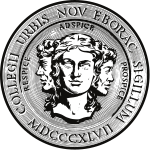 | |
Other names | City College of New York City College |
|---|---|
Former names | Free Academy of the City of New York (1847–1866) College of the City of New York (1866–1929) City College of New York (1929—1961) |
| Motto | Respice, Adspice, Prospice (Latin) |
Motto in English | "Look behind, look here, look ahead" |
| Type | Public research university |
| Established | 1847 |
| Founder | Townsend Harris |
Parent institution | City University of New York |
| Accreditation | MSCHE |
Academic affiliations | |
| Endowment | $290 million (2019)[1] |
| President | Vincent G. Boudreau |
| Provost | Tony Liss |
Academic staff | 581 (full-time) 914 (part-time) |
Administrative staff | 401 |
| Students | 14,489[2] (Fall 2022) |
| Undergraduates | 13,113 |
| Postgraduates | 3,048 |
| Location | , , United States 40°49′10″N 73°57′00″W / 40.8194°N 73.9500°W |
| Campus | Large City, 35 acres (0.14 km2) |
| Newspaper |
|
| Colors | Lavender/purple, gray, and white[3]
|
| Nickname | Beavers |
Sporting affiliations | NCAA Division III – CUNYAC |
| Mascot | Benny the Beaver |
| Website | ccny |
 | |
The City College of the City University of New York (also known as the City College of New York, or simply City College or CCNY) is a public research university within the City University of New York (CUNY) system in New York City. Founded in 1847, City College was the first free public institution of higher education in the United States.[4] It is the oldest of CUNY's 25 institutions of higher learning[5] and is considered its flagship institution.[6]
Located in Hamilton Heights overlooking Harlem in Manhattan, City College's 35-acre (14 ha) Collegiate Gothic campus spans Convent Avenue from 130th to 141st Streets.[7] It was initially designed by renowned architect George B. Post, and many of its buildings have achieved landmark status. City College's satellite campus, City College Downtown in the Cunard Building at 25 Broadway, has been in operation since 1981. It offers degree programs for working adults with classes in the evenings and Saturdays.[8]
Other primacies at City College that helped shape the culture of American higher education include the first student government in the nation (Academic Senate, 1867);[9] the first national fraternity to accept members without regard to religion, race, color or creed (Delta Sigma Phi, 1899);[10] the first degree-granting evening program (School of Education, 1907); and, with the objective of racially integrating the college dormitories, "the first general strike at a municipal institution of higher learning" led by students (1949).[11] The college has a 48% graduation rate within six years.[12] It is classified among "R2: Doctoral Universities – High research activity."[13] The institution has graduated ten Nobel Prize winners, one Fields Medalist, one Turing Award winner, three Pulitzer Prize winners, and three Rhodes Scholars.[14][15][16][17] Among these alumni, the latest is a Bronx native, John O'Keefe (2014 Nobel Prize in Medicine).[18]
- ^ City College unveils new combined foundation with $290m endowment; Martin Cohen '70 & Dave Wall '97 head distinguished board. CCNY Foundation. 26 December 2019.
- ^ "College Navigator - CUNY City College". National Center for Education Statistics. Retrieved August 11, 2024.
- ^ "College Colors" (PDF). The City College of New York Style and Brand Guidelines. July 17, 2018. p. 4. Retrieved October 15, 2019.
- ^ "... the founding, in 1847, of the Free Academy, the very first free public institution of higher education in the nation.", Baruch College history website. [1] Archived July 25, 2006, at the Wayback Machine
- ^ "CUNY's list of its 23 institutions". Archived from the original on March 27, 2007.
- ^ "CUNY Seeing Fewer Blacks at Top Schools". The New York Times. August 10, 2006. Retrieved December 7, 2016.
- ^ CCNY campus map Archived March 17, 2007, at the Wayback Machine which shows the lower section extending to 130th St. where the new Towers dormitory is, and up north to 141st St. where Steinman Hall ends and CCNY Alumni House stands.
- ^ "Division of Interdisciplinary Studies at the Center for Worker Education". The City College of New York. July 6, 2015. Retrieved April 27, 2020.
- ^ Admin, Website (June 30, 2015). "Our History – The City College of New York". Retrieved December 7, 2016.
- ^ Fn: Philosophy of Delta Sigma Phi, December 10, 1899. Delta Sigma Phi Archives, Indianapolis, IN.
- ^ Cite error: The named reference
GoodmanNYT1984was invoked but never defined (see the help page). - ^ "City University of New York: City College | CCNY | The College Board". bigfuture.collegeboard.org. Archived from the original on August 26, 2021. Retrieved June 30, 2020.
- ^ "Carnegie Classifications Institution Lookup". carnegieclassifications.iu.edu. Center for Postsecondary Education. Archived from the original on March 31, 2022. Retrieved September 12, 2020.
- ^ "Jesse Douglas | American mathematician". Encyclopedia Britannica. Retrieved August 3, 2018.
- ^ "Robert Kahn - Engineering and Technology History Wiki". ethw.org. Retrieved August 3, 2018.
- ^ Brennan, Elizabeth A.; Clarage, Elizabeth C. (1999). Who's who of Pulitzer Prize Winners. Greenwood Publishing Group. ISBN 9781573561112.
- ^ "Colleges and Universities with U.S. Rhodes Scholarship Winners | The Rhodes Scholarships". www.rhodesscholar.org. Retrieved September 30, 2018.
- ^ "John O'Keefe, Class of '63, Wins Nobel Prize". Ccny.cuny.edu. Retrieved July 15, 2015.